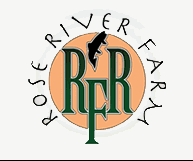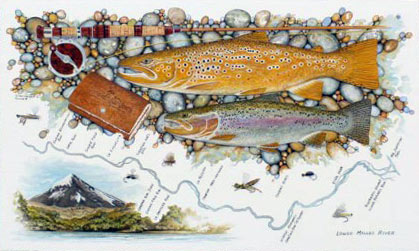Fly Selection!
Your source for flyfishing and flycraft resources since 1975.
There must be, literally speaking, 100,000 different flies from which to choose! So the big question is, "Where do I start?"
As usual, I'm going to make this as simple as I possibly can. If you've been fly fishing for a while now, you probably won't find this page very useful. But if you're just beginning or are helping someone learn for the first time, this brief discussion will be useful.
First, I must quickly define a fly. A "fly" is the result of tying materials such as, but not limited to, hair, fur, feathers, rubber, mylar, silicone, lint, plastic and foam, to a hook whereas the end product is used to catch a fish using a fly rod. That's really it. If you make something to look like a fish, mouse, fly, worm, bug or whatever, we're still going to call it a "fly."
And there are a few type of flies: Dry, Wet, Terrestrial, Streamer and Nymph
The "dry" fly is one that floats on top of the water.
A "wet" fly refers to all the rest.
A "terrestrial" is a type fly which mimics a land based bug, like a grasshopper, ant or beetle. I consider these as a type of dry fly
A "streamer" is a type of wet that one typically fished in a manner that will mimic the 'swimming' motion of a baitfish or larger insect.
The "nymph" is a type of wet that is best described as a small bug that drifts freely in the water.
Examples of flies
| Some examples of flies | |
|---|---|
| Dry | Wet |
| Terrestrial | Streamer |
| Nymph | |
Quickest Way to Select a Good Fly
Without a doubt, the quickest and often the best way to select a good fly is to ask someone else! I'm serious. On or near many fishable waters you'll find a fly shop that'll be more than glad to give you some ideas of which flies will work, so just stop in and ask. Don't be intimidated by what you don't know; even seasoned anglers will ask about what's hot at a given time.
You can also ask a friend or someone else who is familiar with the place you intend to fish. A good friend, and at times even a good 'fishing stranger,' will give you a couple of flies to try. If so, always . . . always, always, ALWAYS say yes! This is usually a good sign that the advice will be pretty good. Most folks that enjoy fly fishing will be glad to share ideas and products with you, but don't forget that they've arrived at the same place you have to fish, not to talk.
My wife has the best scheme. She'll say something like, "Honey, can I have some flies?" or "What fly do you think I oughta use?" Then she'll kinda scoot over close, point to something in my fly box and say, "Ohh, I really like that " flashy red thingy with the bead' on it, can I have that?" I of course say yes, but then she'll also pluck the fly right out of my hand, that I'm getting ready to tie on, and says, "I'll try that too!" As far as I can tell, this is a pretty good method because Carolyn usually catches a few fish!
This is a good place to mention that you will, undoubtedly, run into people on the stream who are unwilling to share information, are unhappy you are fishing at their favorite spot and overall miserable. Often times, these qualities are combined with a zealousness about fly fishing, an overblown sense of fly fishing knowledge and an all around bad attitude. Fly fishing, for some reason, can attract folks who define their whole lives by the sport and take themselves, and their fly fishing, way too seriously. These people are to be totally avoided. They may have a huge inventory of fly fishing information, but even if they're willing to share it, you'll find that a good book on the sport will be easier to understand and much, much more enjoyable to be with.
So the next step is deciding for yourself.
When thinking about which fly to use, consider what most fish eat: bugs and other fish. That's not exactly 100% of the picture, but it's darn near 95%! So the budding fisherman would look at the water he intends to fish and actually try to determine what the fish are eating. Looking for things that crawl, swim, float, drift, jump or fly in and around the water is an excellent start.
Remember that "bugs" encompasses a whole range of things that you'll find 'in' the water, like squishy red things, gray thing with lots of legs, brown egg shaped things and so on. But don't forget that "bug" are also things you find that usually belong on the land such as ants, beetles, grasshoppers and so on. You should pay attention to all of these kinds of bugs that in the environment as they're damn good indicators of bugs which the fish might find tasty. That covers bugs for now.
The fish a fish'll eat is basically any fish that it can get into their mouth. It true what they say about the big fish swallowing the little fish, and so on. In this case you should pay attention to the little fish in the water that might look tasty to the larger fish. Remember that if you using a fly
That would be enough said about bugs and fish, however there is one phenomenon that is obsessively attractive to the trout fisherman, and than phenomenon is the emergence of the dry fly. You see, when explaining about some of the bugs found in the water, I didn't come completely clean with you because I wanted to save the best for last.
Although most of these bugs spend most of their time moving around the bottom of streams and rocks, there comes a time when they transform from a little squishy bug into something that eventually can fly. It only takes a day or two for the swimming bug to emerge in a flying bug, which is called an adult bug. Since these bugs fly, we naturally call them (and their juvenile counterparts) flies! Once they grow wings, come to surface of the water and dry out, they're known as "dry" flies. It is of particular fun to catch a fish on a dry fly because you can see it happen on the surface and it is a very exciting way to catch a fish.
For the record, a dry fly, or adult, is usually only such for a day or two. They effectly 'hatch' on the surface of the water, flyand then find a mate and have sex for a whole day. The male dry fly, having done his part, then dies from his heroic but exhaustive effort -- this is called a 'coffin' fly and fresh water fish will eat it as it lands on the water. The female, on the other hand, is laying her fertilized eggs on the water with the hope that these will eventually have the opportunity perform as she just did. Watching them lay eggs on the water's surface is fun, especially when you see a fish unexpectedly come up from under to eat it. This is the "Holy Grail" of many, but not all, fly fishing folks.
Before we get into more details, there are two broad categories in which we can put the different type of flies with which we fish. The first is called "imitators." These, as the name suggests, are made to reproduce, as accurately as we can, the appearance of the bug or fish we think the fish will eat, as closely as possible. In other words, the fly (we tie) imitates the actual bug or fish that we believe might tempt the fish we want to catch.
The second category, or type of fly, is what we call "attractors." These flies do not imitate anything in particular, but still manage to, well . . . attract the fish! Sometimes we tie (or buy) these attractor patterns which look like nothing in particular or sometimes we tiem the that contain particular attributes from several different bugs, but looks like no particular bug itself. I like these cause they usually have cool names like "Twisted Sister," "Fat Albert," "Crazy Charlie," "Todd's Wiggle Wog," "Psycho Prince" and so on. And the neatet thing is when you tie these, they don't have to look like anything in particular, which sure takes a lot of pressure off of me. As long as they'll catch fish, you can call them a good fly -- at least that's my definition!
Size Matters
Flies are measure like wire gage; the bigger the number the smaller the fly. So a 10 is bigger than a 18. If it has an "O" after it, it's even bigger so a 1/0 is bigger than a 2 and a 4/0 is bigger than a 2/0. They come in sizes because the bugs, baitfish, insects that fish eat appear in different sizes. If something is called a "midge," that just means it's really, really small. If you're new to fly fishing, it's difficult to grasp the idea that these will be useful, let alone visible, but after a bit of experience, you'll learn that midges can turn a day of fishing into a day of catching.
Timing is Everything
All you need to know here is that certain bugs and baitfish tend to 'show up' at certain times of the day and/or certain times of the year. So a "Blue Winged Olive" many be more prolific in say May, than it is in October. And whereas a grasshopper pattern is fun to use, you're bound to be more successfull with the pattern in late summer than you are in early spring.
As I told you at the top of this page, the list of flies is virtually endless. If you figure out what kind of fish you're after and where & when you're going to go after them, you're well on your way to figuring the whole thing out. For instance, if I were going to fish the Madison River in August for trout, I could Google it and get a pretty good idea of what I'd need in my fly box.






